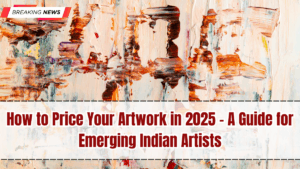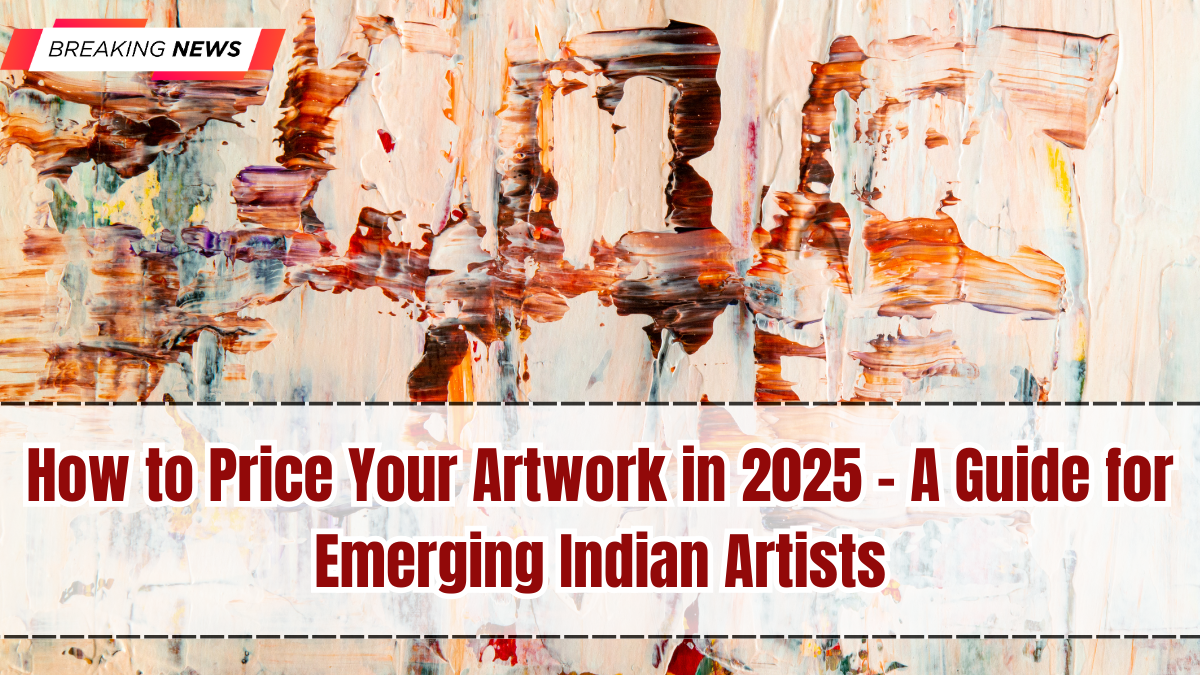For emerging artists, one of the most daunting questions is how to price their work. Too high, and it risks alienating buyers. Too low, and it undervalues creativity and effort. In 2025, with India’s art market becoming increasingly dynamic, finding the right balance is more important than ever. The How to Price Your Artwork in 2025 guide aims to help new artists navigate valuation strategies, understand market trends, and confidently set fair prices that reflect both artistic worth and buyer expectations.
With online platforms, galleries, and digital art formats like NFTs expanding opportunities, Indian artists today have a broader audience than ever before. Pricing, however, remains both an art and a science, requiring knowledge of costs, competition, and perceived value.

Why Pricing Artwork Matters
Correct pricing does more than generate income—it shapes an artist’s reputation and market standing. A well-thought-out price communicates professionalism, confidence, and long-term vision. The How to Price Your Artwork in 2025 approach highlights that pricing is not just about covering material costs; it is about aligning with industry benchmarks while ensuring sustainable growth for the artist.
Factors to Consider in Pricing
Artists must look beyond intuition and consider multiple factors when setting prices:
-
Material Costs: Paint, canvas, digital tools, framing, and other inputs must be covered.
-
Time and Labor: The hours spent creating the artwork should be factored into its value.
-
Skill and Experience: Emerging artists may charge less initially but should increase prices as recognition grows.
-
Size and Complexity: Larger or more detailed works generally command higher prices.
-
Market Demand: Art tied to popular themes, styles, or current cultural movements may attract higher buyers.
-
Exhibition History: Works displayed in galleries or exhibitions often gain added value.
By combining these elements, artists can arrive at a fair base price that reflects true value.
Pricing Methods for Artists in 2025
Several established methods can guide the How to Price Your Artwork in 2025 process:
-
Square Inch Method: Calculate price based on artwork size. Example: ₹20 per square inch for emerging artists, scaling up with recognition.
-
Hourly Rate Method: Set a per-hour labor rate and add material costs.
-
Comparable Pricing: Research what similar artists in the same market charge and adjust accordingly.
-
Tiered Pricing: Offer small, affordable works to attract new buyers while maintaining higher prices for larger or signature pieces.
Artists should avoid sudden price jumps, instead raising prices gradually to maintain trust and consistency.
The Role of Galleries and Online Platforms
In 2025, Indian artists sell through both physical galleries and online platforms. Each has its influence on pricing:
-
Galleries: Often take a commission (30–50%), so prices must account for that. Gallery representation may allow higher pricing due to prestige.
-
Online Platforms: Direct-to-buyer sales on platforms like Instagram, Etsy, or specialized art portals allow competitive pricing with lower overhead.
-
NFTs and Digital Art: For those exploring digital formats, scarcity and uniqueness become the key value drivers rather than physical dimensions.
Understanding platform dynamics helps artists maintain consistent pricing across channels.
Common Mistakes to Avoid
Emerging artists frequently make errors when pricing work. The How to Price Your Artwork in 2025 guide highlights mistakes such as:
-
Undervaluing art to attract quick sales
-
Overpricing due to emotional attachment
-
Inconsistent pricing across platforms
-
Ignoring hidden costs like packaging, shipping, and promotion
Avoiding these mistakes ensures long-term career growth and credibility.
Tips for Confident Pricing
-
Document all costs in a pricing sheet for transparency.
-
Set a minimum price threshold below which you never sell.
-
Offer installment plans for higher-value works to attract wider buyers.
-
Raise prices gradually as recognition, demand, and exhibition history grow.
-
Communicate clearly with buyers about why the price reflects the value.
Confidence in pricing translates into stronger buyer trust.
Conclusion
The How to Price Your Artwork in 2025 guide emphasizes that pricing is both a strategy and a mindset. By considering costs, demand, reputation, and market standards, emerging Indian artists can set fair and sustainable prices. In a market where opportunities are expanding rapidly, getting pricing right ensures not only financial returns but also long-term credibility. Artists are encouraged to research, experiment, and evolve their pricing approach as their careers progress.
FAQs
What is the best pricing method for emerging Indian artists in 2025?
The square inch and comparable pricing methods are popular starting points.
Should artists increase prices every year?
Gradual increases are recommended as demand, recognition, and exhibition history grow.
How do online platforms affect pricing?
They reduce overheads but require consistency with gallery pricing to maintain credibility.
Is it okay to sell small works at lower prices?
Yes, tiered pricing helps attract new buyers while maintaining value for larger works.
What should artists avoid when pricing?
Avoid undervaluing, overpricing due to emotion, and inconsistent pricing across platforms.
Click here to know more.
